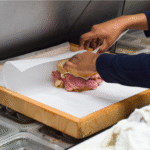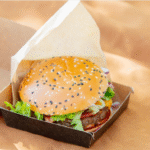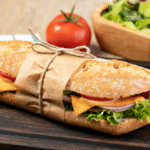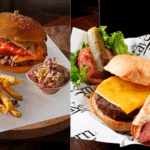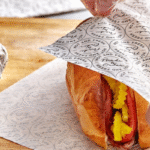What is Wax Paper?
Wax paper is termed a kind of paper that has been laminated with wax, normally paraffin or soy wax. This coating also makes it waterproof and somewhat least adhesion and therefore ideal for cooking and food storage. Even though wax paper is not suitable for the oven unlike parchment paper which is good for baking and can stand heat, this type of paper can melt or even catch fire.
Benefits of Using Wax Paper for Food Storage
There are some benefits of using wax paper for the storage of foods. First, it prevents any condensation which may make the food wet or even become stale. It provides easy release and can be used to wrap foods such as sandwiches or biscuits, with a lot of ease.
That is why wax paper is easy to cut and shape so you can use it for various purposes associated with food storage. Furthermore, the cost is normally low and the product is easily accessible most of the time, especially for many families. Most wax papers in the market today can be reused and decomposed hence making it more environmentally friendly than plastic wraps.
Best Practices for Storing Food with Wax Paper
Choosing the Right Wax Paper
Therefore when choosing wax paper ensure that is food-safe and does not contain any harmful chemicals. Recent wax papers are renewable and can be sourced from recycled items, making your food storage even more environmentally friendly.

Preparing Food for Storage
However, it should be borne in mind that the preparation of food to be wrapped in wax paper is critical. Never wrap pop warm foods as they will end up making the wrapper or foil slimy and greasy. While wrapping, for example within a foil to warm food, it may lead to suffocating the food and making it soggy. Cheese or meat for instance need to be portioned so that they can easily fit on the shelf for storage.
Wrapping Food with Wax Paper
Sandwiches and Wraps
The presentation of wax paper makes it suitable for wrapping sandwiches and wraps. To make these gifts begin by placing a sheet of wax paper on a clean surface and placing it flat. Put the sandwich or wrap right in the middle of the wax paper. Over the sandwich fold the sides of the wax paper, then put the sandwich roll side down and start rolling. If necessary you may have to use a small piece of tape to cover to keep the wax paper tight.
Baked Goods
When storing baked items such as cookies, muffins or breads ensure that they have come to room temperature. When you are storing baked foods, use wax paper in between to avoid the foods stuck on each other. Bake Bisquick in a round baking pan until lightly browned, then, wrap the baked Goods around with wax paper and tighten it with string or tape.
Cheese and Deli Meats
For cheese and deli meats portion them in a way that is manageable when preparing to eat. After each portion is ready, it must be enclosed in wax paper and it must be entirely covered. Wrap the items in foil and put them in the refrigerator for them to be fresh.
Storing Fruits and Vegetables
Wax paper can also be used but may not be the best paper for use in fruits and some vegetables as it retains moisture. For apples and pears that are hard to keep from bruising, each should be placed in a separate wax paper before being placed in a cool, dry area.
About the green part of the vegetables, these can wilt very fast if not well stored. For greens, use wax paper light moist clean cloth not soaking wet, put the greens in the damp cloth then cover them with wax paper.
Creative Uses for Wax Paper in Food Storage
Although wax paper is widely used for wrapping foods, you can use it in many other innovative methods. One of the suggestions is to make up simple packages of nuts, dried fruits, or another trail, for example, using food wrap. This method ensures that mop snacks do not get stale and can easily be carried around.
Storing of leftovers can also be done in containers whose interior part is coated with wax paper. This way it is unlikely to stick to the other part and the cleanup is a lot easier. You only have to take off the wax paper when it is time to eat. Similarly, wax paper also improves the presentation of the food in question whether it is used in food wrapping or not. You may use it to line platters or trays used for appetizers during parties or baked products. It looks much nicer and it is easier to clean afterwards too.
Tips for Storing Food Safely with Wax Paper
Do not use wax paper to wrap raw meats or fish products because wax paper doesn’t offer sufficient barrier against bacterial agents. It is common to review wax papers before using them in wrapping food since torn wax paper may compromise the safety of the food preparation process. If you are going to store food for some time, it may be beneficial to put a note in the bags and packages about what food is stored there and when it was stored.
Summary Table of Wax Paper Uses
| Food Type | Best Use |
| Sandwiches and Wraps | Wrap tightly for easy transport |
| Baked Goods | Wrap or layer with wax paper to prevent sticking |
| Cheese and Deli Meats | Wrap each portion individually to keep fresh |
| Hard Fruits | Wrap individually to prevent bruising |
| Leafy Greens | Wrap with a damp cloth in wax paper for freshness |
Conclusion
Wax paper is also suitable for food storage as it is biodegradable, it does not react with water and it is very easy to use. It shows common methods of wrapping and storage of foods to prevent spoilage and create the best conditions for the storage of delicious meals. In every kitchen, wax paper is useful whether you’re wrapping sandwiches for lunch, storing baked goods, or putting together snack packs. Stop neglecting wax paper and accept the fact that it can improve your food storage and utilization processes.


